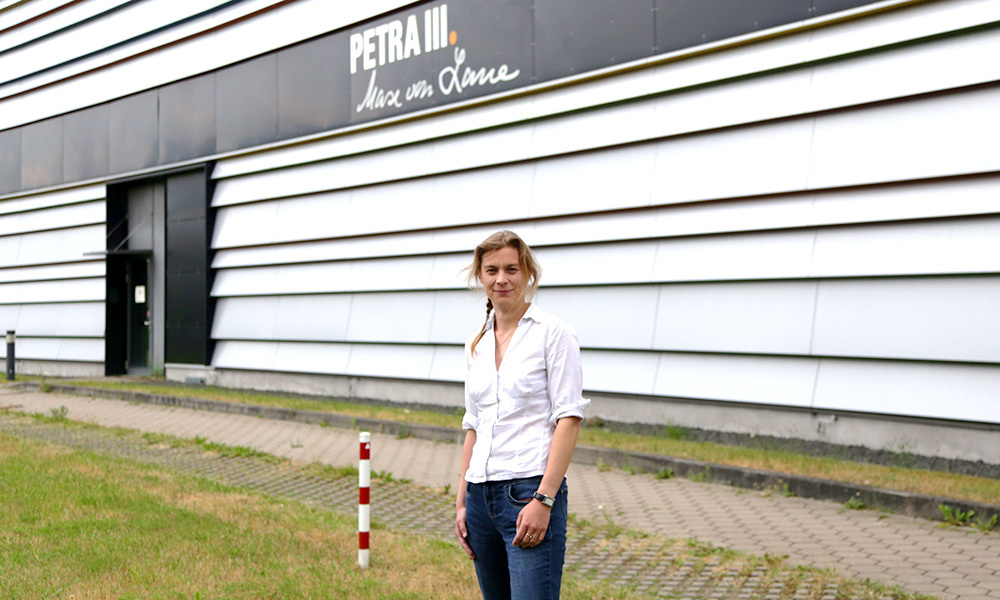
We are EMBL: Selina Storm on PETRA IV and new perspectives for EMBL Hamburg
EMBL@PETRA IV Programme Manager explains how research and services at EMBL Hamburg will benefit from the planned synchrotron upgrade

EMBL Hamburg and its user community carry out X-ray experiments on biological samples using the three EMBL beamlines located at PETRA III, the synchrotron storage ring operated by the Deutsche Elektronen-Synchrotron (DESY). DESY plans to upgrade PETRA III to the latest accelerator technology, PETRA IV, which will transform it into an extremely powerful 3D X-ray microscope for chemical and physical processes. In line with this development, EMBL is proposing an Integrated Facility for X-ray scattering, diffraction, and imaging, enabling non-specialists in X-ray technology to utilise high-end synchrotron radiation for biological research.
Selina Storm is the EMBL@PETRA IV Programme Manager. She coordinates EMBL’s involvement in the planning of the upgrade to ensure EMBL’s activities are aligned with DESY and other stakeholders. Here, she speaks about her role and the new opportunities that PETRA IV will open up for EMBL.
What new opportunities will PETRA IV open up for EMBL Hamburg?
PETRA IV will have enormous potential for addressing challenging biological questions.
The exceptionally precise X-ray beam at PETRA IV will facilitate the acquisition of more detailed protein structures in macromolecular crystallography experiments. The boundaries for 4D-studies could be pushed, particularly for observing the time-course of chemical reactions on shorter time-scales. This could enhance our understanding of enzymes and facilitate drug design efforts.
The exceptional X-ray beam properties at PETRA IV will also enable high-throughput, low-volume data collection strategies for small-angle X-ray scattering (SAXS). This will elevate solution SAXS as an exceptionally advanced screening tool for the structural characterisation of biomolecules and nanoparticles. Additionally, it will expand the possibilities to study the solution state of biological macromolecules under varying conditions (e.g. pH, temperature) and over time (4D SAXS).
Furthermore, the recently started activities in X-ray imaging will greatly benefit from PETRA IV. Increased phase contrast of the beam will improve the quality of X-ray imaging data from low-absorbing and unstained samples, making it possible to visualise the investigated specimens in greater detail. Moreover, the higher photon flux at PETRA IV will enable high throughput data acquisition pipelines and systematic exploration of large sample cohorts. This technique is an essential part of multimodal correlative imaging, where imaging methods using different contrast mechanisms on different length scales are used to learn about different aspects of the same sample.
What do you think is the most exciting thing about your work?
The most exciting thing about my work is that it offers me the opportunity to engage in a wide range of tasks and responsibilities. I can dive deeply into technical details in discussions with my colleagues working on the beamlines, learn about the management of a huge project such as PETRA IV by going to many DESY meetings, and discuss the strategic aspects of collaboration on different levels with the EMBL leadership. I am still involved in the day-to-day business at the macromolecular crystallography beamlines by doing local contacting, and every now and then, there is even a little time for my own research.
How important do you think collaboration is to achieving your goals?
Collaboration is absolutely key – I need to rely on the expertise of my colleagues at the beamlines when it comes to the planning of PETRA IV, the experience of the leadership when it comes to strategic questions, and even on the Legal team when it comes to formal agreements with stakeholders.
What’s the best part of working at EMBL?
Its internationality – it’s amazing that people from so many different countries are working here.
What do you do in your spare time?
If there is real free time, I go up to the Baltic sea, either stand-up paddling with my daughter or windsurfing. On rainy days, I enjoy reading. If I had some more time, I would go more often to concerts or to the theatre with my husband and play some more music myself.
At what age did you decide you wanted to be a scientist?
I’ve always been curious about the stars and wondered what would be out there. I was 11 or 12 when I visited a friend who had a telescope and a beautiful picture of the horsehead nebula. Since then, I wanted to become an astrophysicist. I still have a picture of the Horsehead Nebula hanging in my office.


